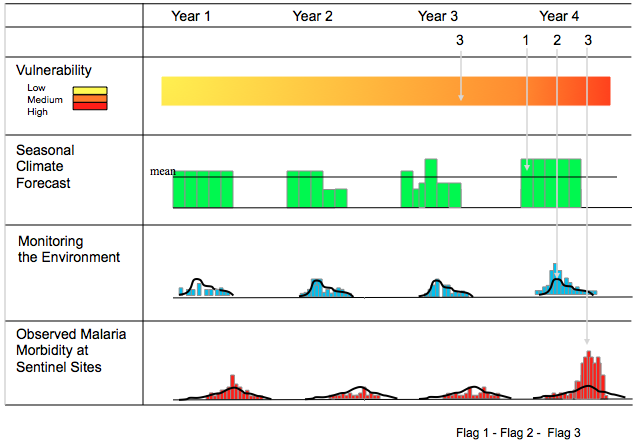Malaria Early Warning System
The Malaria Early Warning System (MEWS) aids in the prediction of malaria outbreaks. The system consists of four elements; Vulnerability, Seasonal Climate Forecasts, Monitoring the Environment and Observed Malaria Morbidity. In certain regions, these products may be used to determine the timing and severity of an outbreak.
This maproom outlines each element of the MEWS. Each element contains products, some of which may be used to help determine the risk of a malaria outbreak in a specific region.

Using all of the elements as a system may be useful in understanding the socioeconomic and climatic drivers of malaria in particular regions. The diagram above depicts how the four elements can be employed on different time scales using flags to raise concern of a potential outbreak.
Climatic and environmental variables can indicate an increased risk in vector (mosquito) and malaria parasite development (when inside its mosquito host). Examples of such indicators include precipitation, temperature, humidity and surface water. The Seasonal Climate Forecasts can predict likely changes in climatic and environmental risk several months in advance while climate and environmental monitoring products provide concrete evidence of such changes and can be used to indicate changes in malaria risk several months ahead of a potential epidemic. The Vulnerability indicators are necessary to indicate the likely severity of any change in malaria transmission risk while the observed case data from health facilities provides the first evidence that an epidemic is underway.
- Vulnerability: Socioeconomic indicators are monitored continuously and determine the vulnerability of a specific region. These indicators are especially useful in predicting the severity of potential outbreaks. Examples of such indicators may be low immunity, malnutrition, HIV, population movement and drug resistance.
- Seasonal Climate Forecast: Changes in global circulation patterns can indicate a lagged change in local climate with a 1-6 month lead-time for specific regions of the world and in specific seasons. Where applicable, these long-term forecasts may be useful in implicating the timing of a potential outbreak.
- Monitoring the Environment: Routine monitoring of climatic variables may allow users of the system to predict the timing and location of epidemics in vulnerable populations. One of the prime methods of monitoring the environment is remote sensing using satellites. Routinely updated meteorological station data can also be used.
- Observed Malaria Morbidity: Early detection using strategically placed sentinel sites may allow for the confirmation of the onset of an outbreak.
References:
Thomson M., Indeje M., Connor S., Dilley M., Ward N. Malaria early warning in Kenya and seasonal climate forecasts. The Lancet. 2003, 362:9383.
WHO: Malaria Early Warning Systems - Concepts, Indicators and Partners - A Framework for Field Research in Africa. WHO/CDS/RBM/2001.32..Geneva: World Health Organization; 2001.










